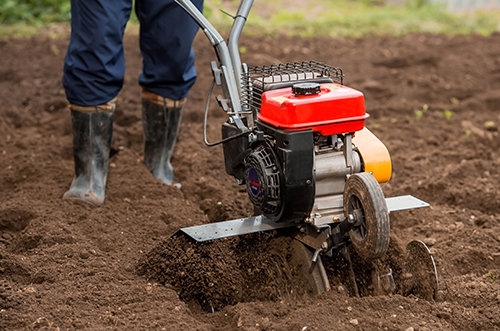Choosing the Right Tiller
Jan 30, 2023

Gardening season will be here before you know it. Whether you’re a seasoned professional or just getting started, finding the right tiller is an important first step and is something you should be considering right now, before spring arrives.
Tillers make your job easier and your soil healthier by breaking up hard ground and aerating the soil. With so many models on the market, though, choosing the best one is all about weighing each option — including tine placement, engine type, and wheel size — and finding the right fit for you.
Front-tine tillers
Front-tine tillers are lightweight but handy. Because the tines rotate forward, they actually help propel the machine along for easy maneuverability. These tillers are best suited for loosening soil that has already been prepared, and due to their narrow design, they are often used for weed control between garden rows. Because they are small and lightweight, front-tine tillers are one of the most affordable options; however, they lack the durability and versatility of more heavy-duty tillers.
Rear-tine tillers
Rear-tine tillers are larger, hardier machines. The tines can rotate in three different ways — forward-rotating, which helps to push forward and blend soil; counter-rotating, which helps to dig deeper; and dual-rotating, which allows switching between the modes. Although these tillers can be used for weeding and blending, the large engine is best suited for breaking up new ground, especially in sandy or loamy soil. They are user-friendly and easy to maneuver, and their all-hydraulic system makes them an excellent choice for heavy or repeated use.
Engine type
Gas-powered tillers are the most powerful type, as well as the most portable since they are not dependent on having an electrical outlet nearby. However, because they contain a larger number of moving parts, increased maintenance can make gas-powered engines too costly for many consumers. Electric-powered tillers are more common and affordable for hobby gardeners. They can be plugged into an electrical outlet and started with the push of a button, and fewer moving parts means these machines require less maintenance. Furthermore, they do not produce near the amount of noise that gas-powered tillers do.
Wheel size
Tillers can weigh up to 130 pounds, so good wheels are an essential. Make sure the wheels are large enough to get your tiller from the shed to the garden without wearing you out. The most common tire size on a tiller is 13x5-6, but they can be replaced to meet your needs. If your tiller’s tires become punctured or cut from severed roots or sharp rocks, consider a heavier ply rating.
Once you’ve considered these options, visit your local Co-op. We can help you find the perfect tiller of any size, brand, or type that will match the needs of you and your garden.
For more content like this, check out the latest issue of The Cooperator.
Tillers make your job easier and your soil healthier by breaking up hard ground and aerating the soil. With so many models on the market, though, choosing the best one is all about weighing each option — including tine placement, engine type, and wheel size — and finding the right fit for you.
Front-tine tillers
Front-tine tillers are lightweight but handy. Because the tines rotate forward, they actually help propel the machine along for easy maneuverability. These tillers are best suited for loosening soil that has already been prepared, and due to their narrow design, they are often used for weed control between garden rows. Because they are small and lightweight, front-tine tillers are one of the most affordable options; however, they lack the durability and versatility of more heavy-duty tillers.
Rear-tine tillers
Rear-tine tillers are larger, hardier machines. The tines can rotate in three different ways — forward-rotating, which helps to push forward and blend soil; counter-rotating, which helps to dig deeper; and dual-rotating, which allows switching between the modes. Although these tillers can be used for weeding and blending, the large engine is best suited for breaking up new ground, especially in sandy or loamy soil. They are user-friendly and easy to maneuver, and their all-hydraulic system makes them an excellent choice for heavy or repeated use.
Engine type
Gas-powered tillers are the most powerful type, as well as the most portable since they are not dependent on having an electrical outlet nearby. However, because they contain a larger number of moving parts, increased maintenance can make gas-powered engines too costly for many consumers. Electric-powered tillers are more common and affordable for hobby gardeners. They can be plugged into an electrical outlet and started with the push of a button, and fewer moving parts means these machines require less maintenance. Furthermore, they do not produce near the amount of noise that gas-powered tillers do.
Wheel size
Tillers can weigh up to 130 pounds, so good wheels are an essential. Make sure the wheels are large enough to get your tiller from the shed to the garden without wearing you out. The most common tire size on a tiller is 13x5-6, but they can be replaced to meet your needs. If your tiller’s tires become punctured or cut from severed roots or sharp rocks, consider a heavier ply rating.
Once you’ve considered these options, visit your local Co-op. We can help you find the perfect tiller of any size, brand, or type that will match the needs of you and your garden.
For more content like this, check out the latest issue of The Cooperator.